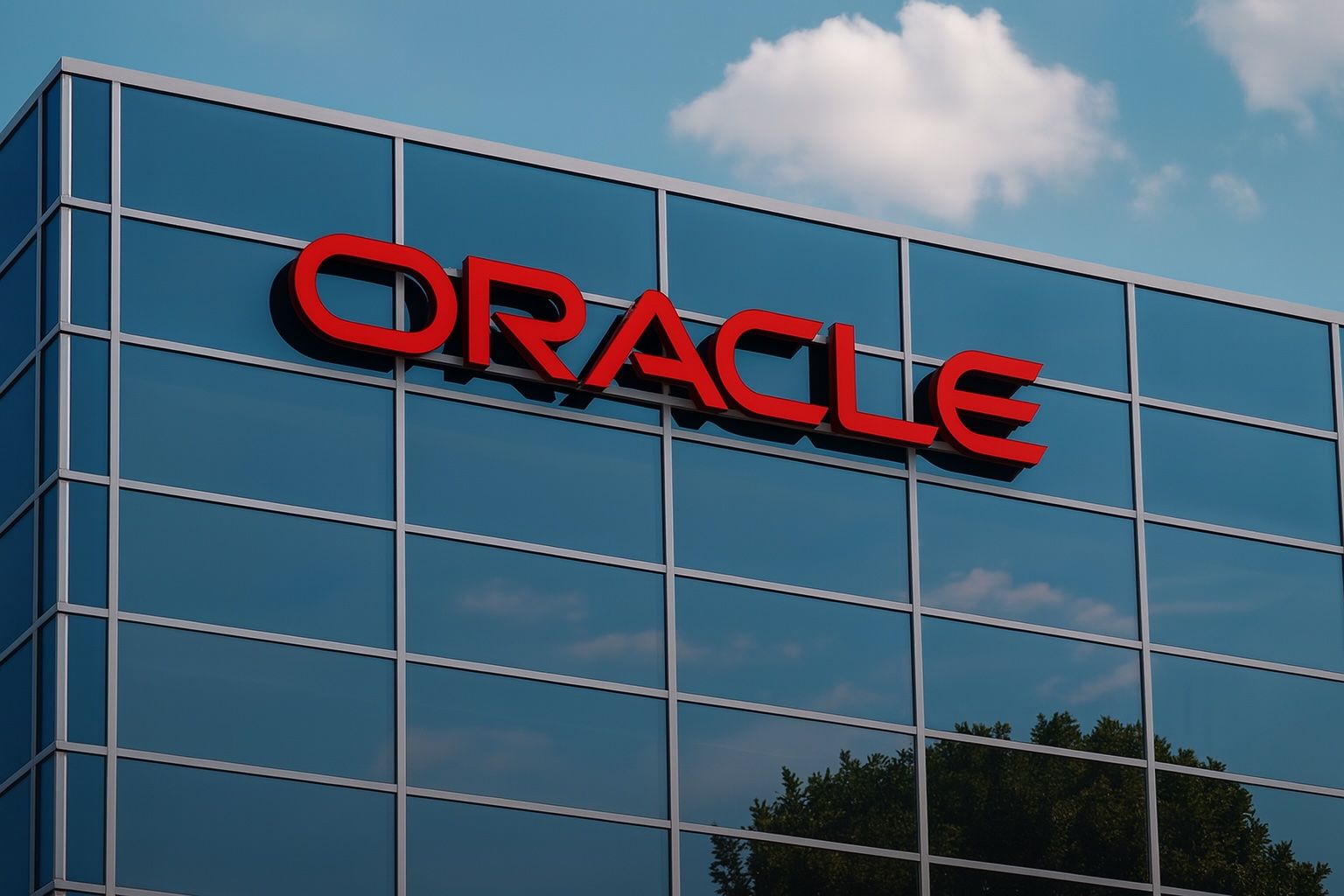Oracle stock (NYSE: ORCL) is trading around $227 after a steep pullback from record highs. Here’s what’s driving today’s move on November 13, 2025, and how analysts, institutions, and technicals are lining up around the AI cloud story.
Key takeaways for ORCL on 13 November 2025
- Price & trend: After Wednesday’s close at $226.99, Oracle is roughly 3.9% below its prior close and about 25–30% below its early‑September record near $345. [1]
- Volatile month: The stock has fallen in 7 of the last 10 sessions, losing about 17.5% over that span, with daily swings around 4–5%. [2]
- AI backlash: New commentary today highlights thin AI infrastructure margins (around 30–40% vs ~80% in legacy software) and questions around Oracle’s $455 billion AI/cloud backlog, feeding the sell‑off narrative. [3]
- Analyst split: Some analysts still see up to 75% upside with a $400 price target, while others call Oracle’s AI push an “irresponsible” high‑risk, low‑margin bet. [4]
- Flows under the surface: Fresh filings today show some institutions adding to ORCL and others cutting stakes sharply, against a backdrop of notable insider selling. [5]
- Next major catalyst: Oracle’s next earnings report is expected on December 8, 2025, with Wall Street looking for around $1.63 EPS and robust cloud growth. [6]
ORCL stock price today: where things stand
As of Thursday, November 13, 2025, most data providers still show Oracle (ORCL) trading around $226–227 in early indications, essentially hovering near Wednesday’s close of $226.99 on the NYSE. That Wednesday session saw the stock drop 3.88% from $236.15, with an intraday range of about $226.2–236.8 and roughly 24 million shares changing hands. [7]
Short‑term technicals look bruised:
- 7 of the last 10 trading days have been red.
- ORCL is down about 17.5% over that stretch. [8]
- The 14‑day RSI sits near 16, a deeply oversold reading.
- There’s near‑term volume support around $226.13, with heavier resistance projected in the $257–277 area. [9]
Despite the recent beating, Oracle is still up roughly 35–45% year‑to‑date, depending on the source and cut‑off date, comfortably ahead of the broader market. [10]
In other words: short‑term trend, ugly; long‑term chart, still very strong.
What’s driving the latest sell‑off?
1. A 25–30% comedown from AI euphoria
Today’s coverage continues to hammer the same headline: Oracle stock has crashed roughly 25–30% in about a month, sliding from record highs near $345 in early September to about $230–236 today. [11]
That pullback didn’t come out of nowhere. Several red flags converged:
- Earnings miss: Oracle’s recent quarter delivered roughly $14.93 billion in revenue versus about $15.04 billion expected, with EPS also coming in slightly below estimates. [12]
- AI margins much thinner than hoped: Reporting around Oracle’s Nvidia‑powered AI cloud business suggested revenue near $900 million last quarter but only approximately $125 million in gross profit – that’s about 14% margin, far below Amazon Web Services’ ~30–35% and Microsoft Azure’s 40%+. [13]
- Costly data center build‑out: Heavy spending on GPUs, power, and new data centers has stoked fears that Oracle’s AI push is capital‑intensive but low‑return, at least for the next few years. [14]
Put simply, investors are asking: is Oracle buying growth at the expense of profitability?
2. Insider selling and “AI hype fatigue”
Today’s coverage also keeps pointing to insider and institutional moves:
- One widely cited note highlights that newly‑promoted CEO Clay Magouyrk sold about 40,000 shares (roughly $11 million) shortly after his promotion, one of several high‑profile insider sales that have unnerved investors. [15]
- Articles today and earlier this week tally around 204,000 shares sold by insiders over the past three months, worth roughly $60 million, even as the AI story was peaking. [16]
At the same time, some commentators argue that the broader AI infrastructure trade has hit a “hangover” phase. After months of huge capex announcements and sky‑high expectations, markets are scrutinizing:
- Actual profitability of AI infrastructure deals.
- Accounting choices – for example, hedge fund manager Michael Burry has publicly criticized Oracle and other AI players for using long depreciation schedules on fast‑obsolescing AI hardware, arguing this artificially inflates earnings. [17]
That combination – insiders cashing out, questions over real economics vs hype, and a crowded AI trade – has been a powerful drag on ORCL in November.
Bulls vs bears: today’s analyst narratives
The bull case: “This pullback is overdone”
On the bullish side, several pieces out today and this week see the slump as a buying opportunity:
- A new TipRanks summary notes that Mizuho Securities analyst Siti Panigrahi has reiterated a Buy rating and a $400 price target, implying more than 75% upside from current levels. She argues Oracle is still well‑positioned to beat expectations when it reports Q2 FY 2026 in December, thanks to massive AI and cloud contracts. [18]
- An earlier Zacks‑sourced analysis, republished on Nasdaq, highlights that in Q1 FY 2026 Oracle delivered around 12% revenue growth (constant currency) to roughly $14.9 billion, with cloud revenues up 27% and cloud infrastructure up 54% year‑over‑year. [19]
- That same report notes that Oracle’s remaining performance obligations (backlog) have exploded to about $455 billion, up roughly 359% year‑over‑year, driven by multi‑billion‑dollar AI and cloud infrastructure deals. [20]
From the bull’s perspective:
- The stock’s 30% drawdown is mostly multiple compression from a very elevated starting point.
- The underlying business is still compounding, particularly in Oracle Cloud Infrastructure (OCI).
- If Oracle comes anywhere close to its long‑term AI/cloud targets, today’s valuation and pullback may look attractive in hindsight.
Oracle’s own long‑term guidance backs that up. At an October analyst meeting, management projected that:
- Cloud infrastructure revenue could reach about $166 billion by FY 2030, roughly three‑quarters of total sales.
- Total company revenue could climb to $225 billion by that date, with adjusted EPS of $21, well above then‑current Wall Street forecasts around $18.92. [21]
Those are enormous numbers – and they underpin the most aggressive $350–$400 price targets you see in today’s and recent research summaries. [22]
The bear case: “Irresponsible AI bet, bad margins”
The bears, however, are getting louder – and today’s Benzinga piece gives them a strong voice:
- Gil Luria, head of technology research at D.A. Davidson, describes Oracle’s AI strategy as “irresponsible” and a “bad business with very low margins”. [23]
- He argues that Oracle is borrowing heavily to build data center capacity for speculative AI startups, whereas rivals like Microsoft, Amazon and Google are building for demand that’s already committed years in advance. [24]
- Luria points out that Oracle’s legacy software and database franchise enjoys gross margins around 80%, while the company itself is guiding to 30–40% margins on its AI infrastructure deals – and presenting that as a win. [25]
The backlog is another flash point. Oracle and many bullish analysts have touted that $455 billion order book as evidence that customers are lining up for its AI cloud capacity. Bears see it differently:
- Luria characterizes parts of that backlog as “false promises”, arguing that some AI customers may never consume anywhere near the contracted capacity.
- Short seller Jim Chanos has likewise questioned how deals rumored to be in the hundreds of billions of dollars – such as Oracle’s massive OpenAI contract – will actually be funded and recognized over time. [26]
Add in the 14% reported margin on some Nvidia‑linked deals and a sharp step‑up in capital expenditures, and the bear case is pretty simple:
Oracle is taking on huge risk and debt for AI infrastructure that may not earn back its cost of capital – and the stock was priced for perfection.
What institutions and hedge funds are doing with ORCL right now
Fresh 13F‑style filings and summaries published today show that big money isn’t moving in one direction.
New buying and stake increases
- Candriam S.C.A. boosted its Oracle stake by 31.2% in Q2, adding nearly 37,000 shares to hold around 155,000 shares valued at just under $34 million at the time of filing. [27]
- EagleClaw Capital Management lifted its position by 3.8% to about 61,000 shares, making ORCL roughly 2% of its portfolio – its 13th‑largest holding. [28]
MarketBeat’s round‑up of analyst sentiment in those pieces notes:
- A “Moderate Buy” consensus rating.
- An average price target around $320–325, well above today’s ~$227 level but also well below the most aggressive $400 calls. [29]
Profit‑taking and insider‑heavy selling
On the flip side:
- First Western Trust Bank cut its Oracle stake by 46.6%, selling about 34,500 shares and leaving roughly 39,600 shares worth around $8.65 million. [30]
- Earlier this week, other filings highlighted funds like Wallace Weitz’s firm significantly trimming their ORCL exposure, consistent with a broader institutional cool‑down on the name. [31]
Across multiple filings, reporters tally more than 200,000 shares sold by insiders in the last 90 days, around $60 million in value, with top executives and directors participating in the selling. [32]
The takeaway:
- Some long‑only managers are buying the dip, treating Oracle as a high‑conviction AI/cloud platform on sale.
- Others – including insiders – appear to be locking in huge AI‑driven gains and de‑risking after the run‑up.
Fundamentals check: is the business actually weakening?
Despite the noisy debate, Oracle’s reported fundamentals still look strong on several fronts.
Recent results
Across its last few quarters:
- Fiscal 2025 Q4 and full‑year results (reported June 11, 2025) showed:
- Q4 revenue up about 11% year‑over‑year to $15.9 billion.
- Full‑year revenue up 8% to $57.4 billion.
- Cloud services and license support revenue up 12% for the year, to about $44 billion. [33]
- Q1 FY 2026 (reported September 9, 2025) reinforced the trend:
- Revenue growth around 12% in constant currency.
- Cloud revenue up 27%, with cloud infrastructure up 50%+. [34]
Those numbers support the idea that demand for Oracle’s cloud and AI offerings is very real, even if the stock price is now adjusting to questions around profitability, capital intensity, and accounting.
Long‑term targets vs short‑term pain
Oracle’s long‑term plan, updated in October, calls for: [35]
- OCI revenue to hit $166 billion by FY 2030.
- Total revenue to reach $225 billion.
- Adjusted EPS of $21/share by then, vs prior consensus under $19.
To get there, Oracle is:
- Building massive data center capacity (including high‑profile AI campuses via multi‑billion‑dollar project‑finance structures). TechStock²+2Reuters+2
- Signing multi‑year AI infrastructure deals with names like OpenAI, Meta, xAI, and others, which have already boosted remaining performance obligations into the hundreds of billions. [36]
For long‑term‑focused investors, today’s sell‑off is about whether Oracle can grow into those targets without permanently crushing margins or overstating backlog quality.
Technical picture and short‑term outlook
From a trading perspective, ORCL currently looks like a fast‑moving, oversold freight train:
- RSI ~16 points to an oversold condition where at least a short‑term bounce wouldn’t be surprising. [37]
- Support from accumulated volume sits just below current prices near $226, while meaningful resistance does not show up until the mid‑$250s and closer to $277. [38]
- Over the past month, the stock has broken below key moving averages and fallen over 30% from its peak, with some technicians warning of downside risk toward the $200 area if selling resumes. [39]
Short‑term quantitative models are mixed:
- One AI‑powered technical service expects ORCL to drift modestly higher over the next three months, with a 90% probability range roughly between $243 and $370, but still labels the stock a short‑term “Sell candidate” due to the negative momentum. [40]
- Crypto‑style forecasting site CoinCodex projects only low‑single‑digit percentage gains for ORCL over the next few days, essentially pointing to sideways‑to‑slightly‑higher price action rather than an immediate V‑shaped recovery. [41]
In the very near term, macro factors are also in play. This morning’s pre‑market commentary linked the weakness to:
- Rate‑sensitive tech valuations reacting to interest‑rate uncertainty.
- A rotation into defensive assets and cash as traders lock in 2025 gains ahead of key economic data. [42]
What to watch next for Oracle stock
For traders and investors looking at ORCL on November 13, 2025, the main checkpoints are:
- Earnings on or around December 8, 2025
- Consensus is centered near $1.63 EPS on revenue around $16+ billion, with particular focus on:
- Cloud infrastructure growth rates.
- Updates on the size and quality of the AI backlog.
- Any margin commentary on AI vs legacy businesses. [43]
- Consensus is centered near $1.63 EPS on revenue around $16+ billion, with particular focus on:
- AI capex and debt narrative
- Expect more scrutiny of debt levels, capex plans, and depreciation assumptions for AI hardware, especially after critiques from figures like Michael Burry and skeptical analysts on today’s newswires. [44]
- Technical behavior around the $220–230 zone
- If ORCL can stabilize and hold above support near $226 and rebuild a base, the “oversold bounce” camp gains credibility.
- A decisive break below that area, especially on heavy volume, would strengthen the case for a test of the $200 region highlighted in recent technical commentary. [45]
Bottom line: how to frame ORCL on November 13, 2025
- Story hasn’t broken; sentiment has. Oracle still reports strong double‑digit cloud growth and a gigantic AI backlog, but investors are now laser‑focused on margins, debt, and accounting rather than just top‑line growth. [46]
- Wall Street is genuinely split. One camp sees a high‑quality AI infrastructure leader on sale, pointing to long‑term guidance and multi‑cloud partnerships. Another sees a levered, low‑margin AI bet that may not justify the premium valuation Oracle commanded at its peak. [47]
- Risk profile is elevated. With big daily swings, a heavily debated AI strategy, and crucial earnings just weeks away, ORCL is likely to remain volatile through year‑end.
For anyone following Oracle today, November 13, 2025, it makes sense to treat ORCL as a high‑beta, event‑driven AI/cloud name: the upside could be meaningful if Oracle proves the skeptics wrong on AI profitability – but the downside risk is equally real if margins or demand disappoint.
This article is for information and news purposes only and does not constitute financial advice. Always do your own research or consult a professional advisor before making investment decisions.
References
1. stockinvest.us, 2. stockinvest.us, 3. m.economictimes.com, 4. www.tipranks.com, 5. www.marketbeat.com, 6. finance.yahoo.com, 7. stockinvest.us, 8. stockinvest.us, 9. stockinvest.us, 10. www.benzinga.com, 11. m.economictimes.com, 12. m.economictimes.com, 13. m.economictimes.com, 14. m.economictimes.com, 15. www.fxleaders.com, 16. www.marketbeat.com, 17. www.marketwatch.com, 18. www.tipranks.com, 19. www.nasdaq.com, 20. www.nasdaq.com, 21. www.reuters.com, 22. www.marketbeat.com, 23. www.benzinga.com, 24. www.benzinga.com, 25. www.reuters.com, 26. www.benzinga.com, 27. www.marketbeat.com, 28. www.marketbeat.com, 29. www.marketbeat.com, 30. www.marketbeat.com, 31. finance.yahoo.com, 32. www.marketbeat.com, 33. www.oracle.com, 34. www.nasdaq.com, 35. www.reuters.com, 36. www.nasdaq.com, 37. stockinvest.us, 38. stockinvest.us, 39. www.fxleaders.com, 40. stockinvest.us, 41. coincodex.com, 42. www.ainvest.com, 43. finance.yahoo.com, 44. www.marketwatch.com, 45. www.fxleaders.com, 46. www.nasdaq.com, 47. www.tipranks.com







